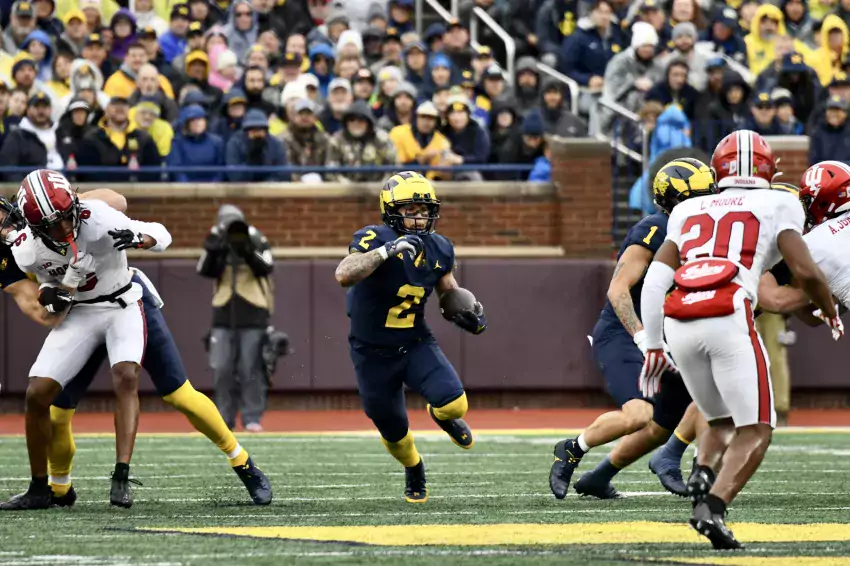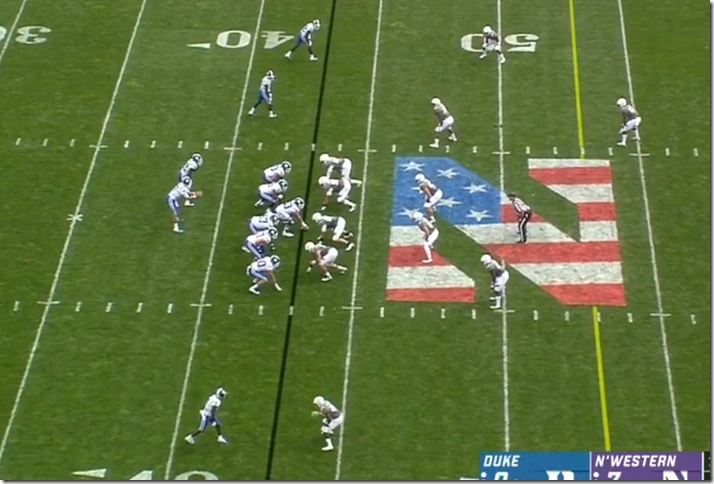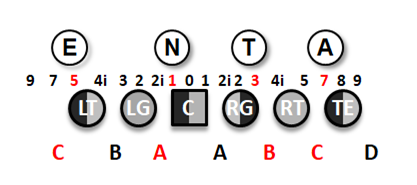running

In Week 2 against UNLV Michigan tried to run Stretch (aka Outside Zone) as their primary counter to Duo, their base running play. It didn't work. The problem with that is if your base running play is inside the tackles you still need something you can run well that goes outside of the tackles. Otherwise your Duo runs are just going to get swallowed up.
This sounds pretty basic. But what kind of outside run could look like Duo/Inside Zone? And how can you spot it? Let's look.
[After THE JUMP: Wrappers]

Shot through the heart, cuz your LB’s too late. [Barron]
In a departure from Michigan’s first few games this season, Down G didn’t work against Northwestern, however a sort of similar A-Gap Isolation play was gashing them on the regular. This was not surprising given how Northwestern aligns its front, a thing I noted in the Foe Film last week.
Base Set: It's a 4-3 even, the same that Michigan State bases its defense out of. Even when they shifted to an under look they kept the wide splits between the DTs:
This is a thing you see Match Quarters defenses do when they like their middle linebacker a lot. The uncovered center can be dangerous since there's nobody to chip him if he releases on a linebacker. If you trust your MIKE to beat that block consistently you can get away with this bubble, making up for it with more strength in the B and C gaps.
And here’s how Harbaugh attacked it:
Before digging into this let's go over some actual football terminology. That way I can use the jargon later to explain why Michigan's curveball play worked so well against previous opponents, but was not expected to work against Northwestern, and why this cut fastball was devastatingly effective.
GAPS, TECHS AND SHADING
Ever since offenses learned to pass and run outside, their opponents have had to array their defenses with some points stronger that others. How you set the strong points of your front and react to the weaker points will establish your defensive identity.
This starts with where you line up the defensive linemen. They are your fortresses. Linemen are difficult to move, and the linebackers usually will line up at least partially behind those lineman to create an impediment for releasing OL to get a shot at them.
Here’s a typical (4-3 over) alignment:
- Techniques are those little numbers I put between the defensive and offensive lines. They are instructions for the defensive linemen as to how they’re going to line up. When we talk about a “3-tech” for example, that’s a guy who lines up off of a guard’s shoulder. There is no single established numbering system across football so I used what I’m familiar with above. Note the numbers in red correspond to where the defensive linemen are set up.
- Shading is an instruction to the offensive linemen, often represented in graphics by coloring in all or part of a lineman to show who’s got a defensive player lined up on him. This comes into play with line calls, zone running, or any play that changes up the blocking depending on how the defense aligns.
- Gaps are represented with letters, and are used by offenses and defenses alike to refer to gap assignments and attack plans. The letters in red denote gaps where a defensive lineman is lined up. An offensive player without a defensive player shaded on him is considered "Uncovered."
- Under/Over can refer to the front as a whole or a player. "Under" means weakside, "Over" means strongside (the side with the tight end)
So in this example alignment you could say the nose is aligned in a 1-tech shaded under the center and attacking the A gap.
Now see if you can find the softest spot in that front above. If you said backside B gap you get a lollipop. Not only is nobody lined up in that gap but the nose is on the opposite side of the next gap, leaving the left guard uncovered. To avoid that, a lot of 4-3 teams will put their nose in a “2i” technique, or over the guard’s inside shoulder, especially when the offense is in a spread formation and there are only two LBs back there to help.
The gaps that aren’t covered are (usually) the linebackers’ problem. Linebacker gaps are more pliable because they have other responsibilities besides that gap, such as passing, matching pullers, and dodging blocks from offensive players not committed to the linemen.
No team stays in the same front with the same linemen attacking the same gaps every play unless they want to be mercilessly attacked by plays that go at their weak points. They’ll shift their fronts, and also slant guys into different gaps than they started in, and blitz their other players to stuff up more gaps. But they also try to spend as much time as possible in the front that best uses their talent.
Now, see if you can spot the soft spot in Northwestern’s front:
You get a lollipop.
[After the JUMP: Why this works so well, and Down G wouldn’t]
So yesterday was the first time we really got to try out my brother's new double-TV basement setup. The plan was to watch all of the football for 14 straight hours, but once the Wisconsin game ended the kinderfolk had taken over TV2 and put on the movie that the current generation of kinderfolk cannot stop watching: Frozen. During one lengthy halftime, we acquiesced to a volume swap, and soon enough here's this room full of men in MSU and Alabama and Michigan gear intently watching a (double-) princess flick.
 |
| This won the internet' in December. By Red_Lee |
From what I've managed to piece together of the plot from 30+ partial viewings, there's a snowy kingdom with a rich shipping and ice manufacturing industrial base that comes to be ruled by a princess with magical ice powers. As a kid she shoots her sister with it. Later the sister gets engaged to a prince she doesn't bother to scout, and as a result ice princess accidentally locks her country in a polar vortex. Ice princess then runs off, sings "eff it all" and builds ice castles until her sister shows up, at which point she shoots her sister again. So now she has to come back and make things right, which leads to her shooting her sister a third time, and this slowly turns sis into an ice statue. Then ice princess hugs the statue and cries, and everything suddenly goes back to summer because all along she had the ability to de-ice everything by loving something other than herself.
Message received, Disney. Now that Michigan's leadership is actually focusing on the realm instead of the realm's perception of its leadership, it turns out our wealthy little Nordic fantasy land doesn't have to be a barren, frozen waste-tundra after all.
Bronxblue gave the whole coaching search his Best and Worst treatment. Like the rest of us, he found the whole thing refreshingly sensical, like Michigan was acknowledging factors that created bad decisions in the past, and was approaching the pursuit of Harbaugh and Plan B with a zeal for deliberation and responsibility that Dave Brandon put into presenting himself as deliberate and responsible.
He also got into the meta of reporting on this process. As a rule of thumb, the more a media person is saying "trust ME" instead of "trust THIS INFORMATION" the less you should believe him.
[After the jump, a long discussion of the running game next year, and a moment of zen you don't want to miss]


40